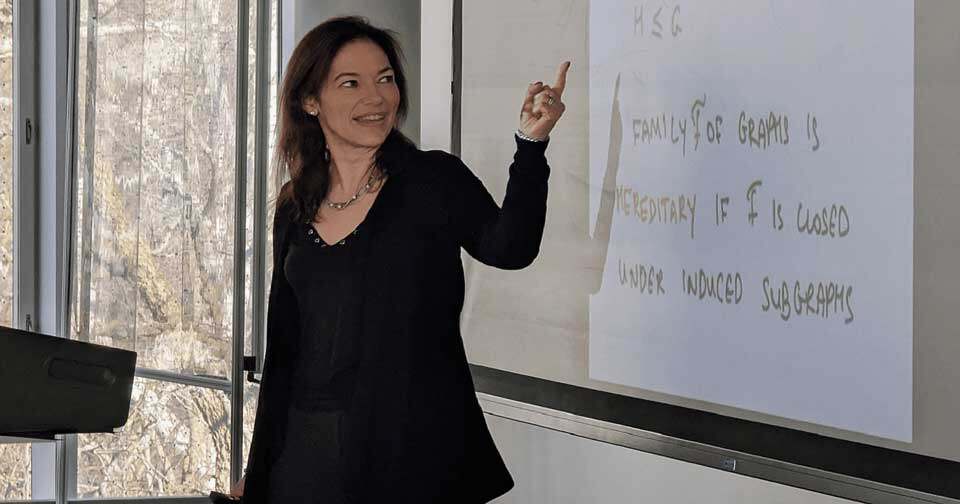

New advancements in neural imaging and recording technologies may provide the key to understanding Alzheimer’s Disease, epilepsy and other disorders.
But as remarkable as these technologies are, they also produce vast and complex datasets that pose a challenge to researchers. New approaches are needed to make sense of this information.
Renowned Princeton University mathematics professor Dr. Maria Chudnovsky is collaborating with scholars from the Western Academy for Advanced Research (WAFAR) to address this problem.
Chudnovsky is associated with Western as a visiting fellow with the “mathematics of neural networks,” an interdisciplinary research theme supported by WAFAR. Leading the project is Lyle Muller of the department of mathematics, with Ján Mináč from the same department and Marieke Mur, assistant professor of psychology and computer science.
Chudnovsky was joined by contributing researchers Sophie Spirkl and Logan Crew from the University of Waterloo’s department of combinatorics and optimization in a lecture in February this year.
The mathematics of neural networks theme is working with Chudnovsky and other experts to develop new computational and mathematical techniques for analyzing neural activities. The team has contributed to new developments about Rett Syndrome, a rare neurological disorder that affects young girls.
WAFAR director Fred Longstaffe sees Chudnovsky as a vital contributor to a team that hopes to bridge the divide between theoretical mathematics and medical practice.
“A world-leading expert in graph theory, professor Chudnovsky provides crucial expertise to the [mathematics of neural networks] team for linking this evolving branch of mathematics to advanced mapping of the brain’s networks and their disruption during neurological diseases.” said Longstaffe.
“We are delighted to have her as a Western Academy visiting fellow.”
Mapping the human brain
Graph theory is a branch of mathematics that is concerned with networks. Researchers use it to investigate everything from subterranean root systems in forests to traffic patterns in urban areas to political polarization in social media communities.
When she was still a graduate student, Chudnovsky gained international recognition in the field when she helped solve a long-standing problem known as the strong perfect graph conjecture. She was awarded a MacArthur “genius grant” fellowship in 2012.
As one of the world’s most renowned graph theorists, Chudnovsky welcomes the opportunity to work with researchers across different disciplines.
“It was very natural for people from the engineering school to come to my office and say ‘do you know how to solve it? Do you want to think about it?’,” she said of her previous work with Columbia University’s engineering faculty.
Chudnovsky’s expertise continues to be highly sought after. In recent years, she has noticed a surge of interest in graph theory.
“Suddenly, everyone is interested in networks,” she said.
For decades, neuroscientists have used graphs to model neural connections, but Chudnovsky’s innovative approach might lead to new advances in how they map the brain’s activities — and dysfunctions.
Mur believes that Chudnovsky’s approach can make it easier for programmers to create computer simulations showing how different regions and networks in the brain interact.
“Neurons can excite each other. They can also inhibit each other depending on their connections and when excitation and inhibition are not balanced the neurons – or a network of neurons – can get into a state where they’re firing [communicating] a lot, very regularly. And that’s a feature associated with epilepsy,” Mur said.
“You can potentially start modeling that.”
The mathematics of neural networks theme is using these techniques to advance their current investigations into epilepsy and long-term memory formation during sleep.
Global expertise at Western’s campus
WAFAR provides scholars with the chance to bring global experts to Western’s campus with the intention of igniting new ways of thinking about urgent problems. The impact of this opportunity extends beyond research.
During her visit, Chudnovsky participated in outreach activities that included a coffee hour with Western’s student chapter of the Association for Women in Mathematics (AWM). She was joined by colleagues Spirkl and Crew.
For Micaela Vancea, AWM Western chapter president, Chudnovsky’s visibility as a self-identifying woman in a male-dominated field proved meaningful.
“Representation is really important and seeing a woman in that kind of position – where she was just so impressive with everything she knew – just seeing someone in a position like that, who resembles you, makes you think, ‘maybe I could be like that’,” Vancea said.
Chudnovsky’s collaboration with the mathematics of neural networks team is only beginning. According to Mur, the research theme is strengthened by the diversity of its membership, who represent a convergence of perspectives from neuroscience, psychology, computer science and mathematics.
“We need to integrate knowledge and skills from all of these fields to understand how the brain supports cognition and behaviour, and it’s hard to get that working, because it’s challenging as an individual to master all of these fields. So that’s why it’s so great to work on this collaboratively,” she said.
In the coming months, the mathematics of neural networks theme will host further collaborations with visiting fellows Alex Lubotzky of the Weizmann Institute of Science, Israel and Christian Maire from the Franche-Comté Électronique Mécanique Thermique et Optique – Sciences et Technologies, France.







































